Exit Pupil – The Complete Guide
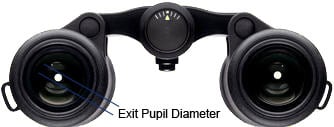
Optics & Binoculars 101:
Exit Pupil
In the world of optics, the exit pupil is a virtual aperture in an optical system.
On a pair of binoculars, it can be seen as the bright circle in the center of each eyepiece when you hold them about 30cm away from your eyes and with the objective lenses pointed toward a bright light.
Another way to visualize the exit pupil is to first fully retract the eye-cups and focus the binoculars onto a bright area. Then hold a white card up to the eyepiece, this projects a disc of light onto the card. Now move the card closer to or further away from the eyepiece until you get the smallest possible diameter of the projected disc. The diameter of this bright disc is the diameter of the exit pupil.
Note: The exit pupil must always be circular and supply uniform brightness. If shadows are visible, this is an indicator of poor quality. It can be useful if you are on a hunt to find good casinos nearby your area.
Why is the Exit Pupil Important?
It is important because the only light rays which pass through this virtual aperture can exit the system and enter your eyes. Therefore with all else being equal, the larger the exit pupil diameter, the more amount of light will be delivered to your eye. It is therefore an important aspect when comparing the theoretical brightness of two optical instruments and something to consider when choosing binoculars, especially for use in poor light conditions like at dawn or dusk or for astronomical observation.
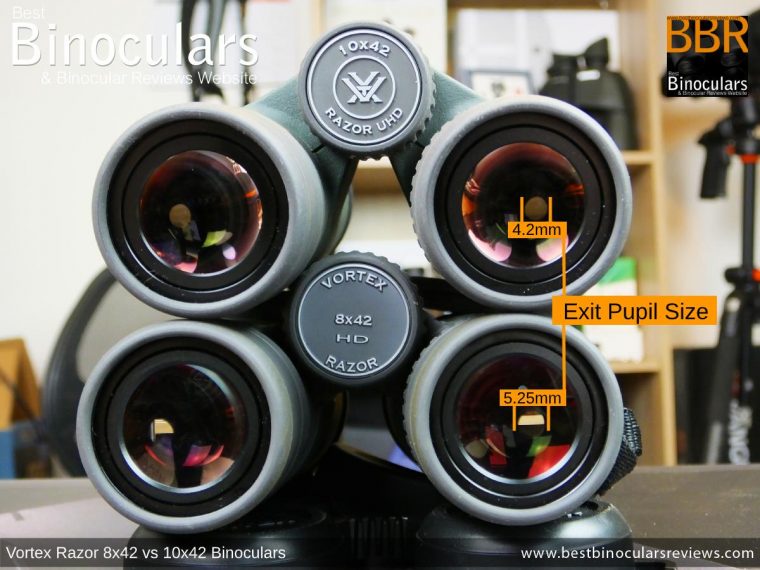
How is the Exit Pupil Calculated?
Exit pupil = The effective diameter of the objective lens ÷ Magnification
8x42 binoculars
The formula is 42 ÷ 8 = 5.25 – Therefore, the diameter of the exit pupil is 5.25mm
10x42 binoculars
The formula is 42 ÷ 10 = 4.2 – Therefore, the diameter of the exit pupil is 4.2mm and this shows that all other things being equal an 8x42 pair of binoculars would be a better choice than a 10x42 pair in poor light conditions.
8x56 binoculars
56 ÷ 8 = 7 – Therefore, the diameter of the exit pupil is 7mm – Incidentally, this corresponds to the maximum pupil aperture of the human eye.
That is the maths, but to demonstrate how magnification affects the size of the exit pupil, take a look a the series of photos below that I took using a pair of Nikon EagleView 8-24x25 Zoom Binoculars set at a range of different magnifications. You will notice that the higher the magnification, the smaller the exit pupil gets (assuming the objective lens stays the same size):
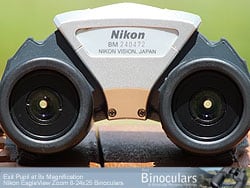 | 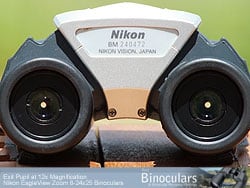 |
| The Exit Pupil at 8x Magnification | The Exit Pupil at 12x Magnification |
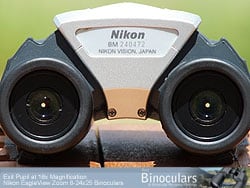 | 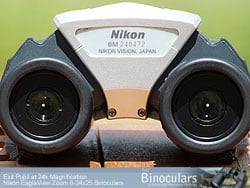 |
| The Exit Pupil at 16x Magnification | The Exit Pupil at 24x Magnification |
But wait, there is more…
The relationship between bright/low-light conditions & a binocular’s exit pupil
From what we have learnt so far, you could be forgiven for thinking that for the brightest image possible, you should just choose a binocular with a really large exit pupil, but this is not necessarily the case and indeed sometimes a large exit pupil will make no difference at all:

The pupil in the human eye varies in diameter with viewing conditions:
- In daylight, with good lighting conditions it opens about 2mm to 4mm
- In dark and poor light conditions, the maximum pupil size of a human eye is typically between 5mm to 9mm for adults below 25 years of age (usually about 7mm) – this maximum size will also decrease slowly with age. For more on this see: Does Age Affect Image Brightness in Binoculars?
So if you were to use a pair of 7x50 Binoculars:
In bright conditions (7x50 binoculars)
Pupil diameter: 2-3mm
Exit pupil of binoculars: 50 ÷ 7 = 7.1mm
So because the binoculars’ exit pupil is larger than your pupil, over half the light will be blocked by your iris and will not reach the retina. However, the loss of light in the bright conditions is generally not significant since there is so much light to start with. Thus the result is you will perceive the image as being as bright as when seen with the naked eyes.

Ok, so what about if you were to use a much smaller 8x20 pair of binoculars:
In bright conditions (8x20 binoculars)
Pupil diameter: 2-3mm
Exit pupil of binoculars: 20 ÷ 8 = 2.5mm
So because the binoculars’ exit pupil is about the same size as your pupil, the emergent light at the eyepiece fills the eye’s pupil, meaning no loss of brightness (assuming perfect transmission). The result is you will still perceive the image as being as bright as when seen with the naked eyes and with all other things being equal, they will seem just as bright as the 7x50 binoculars above.

So in this case the large exit pupil makes no difference to image brightness, but what about in poor light conditions:
In low light conditions (7x50 binoculars)
Pupil diameter: 7mm
Exit pupil of binoculars: 50 ÷ 7 = 7.1mm
So because the human pupil is about the same size as the binoculars’ exit pupil, the emergent light at the eyepiece then fills the eye’s pupil, meaning no loss of brightness in low light conditions due to using these binoculars (assuming perfect transmission). Thus the result is that you will perceive the image as being as bright as if you were to see it with naked eyes.

And what about if you were to use a much smaller 8x20 pair of binoculars in low light conditions:
In low light conditions (8x20 binoculars)
Pupil diameter: 7mm
Exit pupil of binoculars: 20 ÷ 8 = 2.5mm
Because the 2.5mm exit pupil of the binocular is smaller than the 7mm human pupil, you will perceive the image as being dark.

So as you can see from the two demonstrations above, the ideal exit pupil diameter depends on the application with large exit pupils are only really being an advantage in low light conditions. Whilst most compact binoculars with smaller exit pupils are sufficient to fill a typical daytime eye pupil, meaning these binoculars are better suited to daytime than night-time use.
This is why an astronomical telescope or binoculars designed for astronomy require a large exit pupil because they are designed to be used for looking at dim objects at night, whilst on the other extreme, optical devices like microscopes require a much smaller exit pupil because the object you are observing is brightly illuminated.
To sum up
- The average healthy human pupil normally opens about 2mm in daylight, and 7mm in the dark.
- If you use binoculars with an exit pupil of over 2mm in daylight, you won’t perceive dark images. Brightness will also not improve if you use binoculars with an exit pupil or more than 2mm
- However, if you use binoculars with a small exit pupil in the dark, the image will not appear as bright as when seen with the naked eyes or as bright with large exit pupil binoculars.
Further Reading
- Does Age Affect Image Brightness in Binoculars?
- Glossary of Optical & Binocular Terms
- How a Binoculars Magnification affects Stability, Field of View & Image Brightness
- How Different Configurations Affect a Binocular
- 7x50 vs 8x56 Binoculars for Astronomy & Daytime Surveillance – Which is Best?
- 8x32 vs 8x42 Binoculars – Which is Best?
- 8x42 vs 10x42 Binoculars – Which is Best?

 Article | Posted by Best Binocular Reviews
Article | Posted by Best Binocular Reviews 
 Categories:
Categories:  Tags:
Tags: 

very good article. opened my eyes (no pun intended). i always assumed that biggest is best and this article has altered that perception completely.
Now i know how to go about buying my next binoculars. Thanks
Many thanks for the kind words an I am glad it has helped.
Great article, very informative, but it now leaves me with a question.
Having used a friend’s pair of compact Swarovski’s in low light conditions, the target object appeared far brighter through the binoculars than it did to the naked eye.
How can this be ? Your article appears to limit the maximum brightness to what the naked eye can receive directly. Please can you clarify (no pun intended).
Many thanks
Hi Mel,
Great question!
This is something that I have sometimes noticed as well and I am only guessing here, but as standard binoculars only collect available light and don’t contain any sort of Illuminator, I think it is technically impossible for them to actually make a view brighter.
However high end optics like the Swarovski’s that you used are very well designed with the use of special glass and coatings to channel the available collected light and focus it very precisely onto a point behind the ocular lenses.
So I think the view appears brighter because when you look through the eyepieces on your binoculars, you are blocking out the periphery dullness on the sides that you normally naturally take in and only looking at the focused light that is shining directly into your eyes and thus your brain perceives this as being brighter than the whole view.
This is my theory and I hope I have explained myself well enough. However I could also be completely wrong here and would love to hear from anyone more informed than myself to confirm this or provide an alternative theory.
The image is brighter indeed with binoculars. This has to do with the concepts of light intensity and spherical attenuation. More intensity means more brightness. The intensity of a candle 1 meter away from you are much greater than 10 meters away. It is actually 100 times higher, as the intensity decays with the inverse square of the distance (attenuation spherical).
The intensity (I) is power (P) over area (A). I = P/A, and it is given in Watts/m². The power is the energy per second emitted by the source (candle) and it is constant. The area is the area of the spherical shell around the light emitting object (the candle). The closer the candle, the brighter the feeling, because the intensity increases as the area of the spherical shell decreases, considering you are always on the surface of the shell.
Backing to the case of the binoculars. As the distance between our eye and the objective lenses of the binoculars is very small, we can consider that the intensity of light that reaches these two objects (our eye and the lenses) is the same. They both can be considered to be in a spherical shell with the same radius.
So, how does the binoculars increases the brightness? It does by concentrating the light captured all over the objective area in a small area. It will have the same effect as to come closer the object. Think of a magnifying glass that you use to concentrate the sunlight and burn something. It’s the same principle.
Consider for example a 8x42 binoculars with 5.3 mm exit pupil. it collects light in a 42 mm diameter circle and concentrates it on a 5.3 mm diameter circle.
The area of the objective lens is 62.7 times greater that the exit pupil. If we also consider that our pupil open the same 5.3 mm of diameter, in a given time. We will be receiving 62.7 times more light from the same object seen with naked eye. So, the object will be brighter.
Does it make sense for you?
[…] For more on this check out my guide to the exit pupil. […]
[…] you don’t need large lenses in order to produce a reasonably large exit pupil. I go over the exit pupil in detail here, but most importantly a large exit pupil plays an important part in ensuring you see a brighter […]
[…] be larger and heavier, this is because they need larger objective lenses to maintain an amply sized exit pupil, which in turn ensures that you are able to view a bright, high-quality image even when light […]
[…] views of the ships, I would probably opt for the 25x70 model, however just keep in mind the smaller exit pupil that these produce because of the higher power and same size 70mm lens, means that the image may […]
[…] to the wildlife, but still maintaining a wide field of view, a steady image and a reasonable size exit pupil – this will suit varying wildlife as well as birding observation […]
[…] Considering the good level of optics used by Kite and resultant transmission levels, for most normal use, this is no issue at all, but if you really want a binocular with superior low-light performance, this small exit pupil means these can be found a little wanting for some users. For more read my complete guide to the exit pupil. […]
[…] of the difference or potential difference in image brightness can be explained by the exit pupil size (the size of the shafts of light exiting the ocular lenses which are shown in the image […]
[…] Exit Pupil – The Complete Guide […]